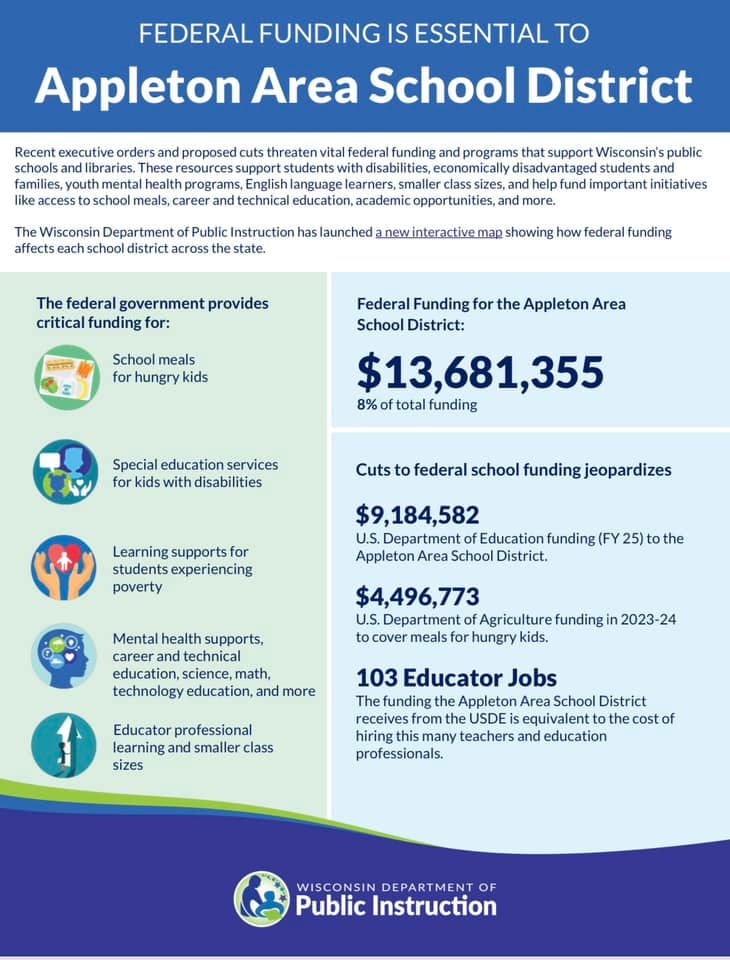Trump's executive order could turn back clock on education
It could drastically reduce funding for vital services for students with disabilities, low-income students, and English learners. The rights of all students to receive an appropriate education are imperiled.

This article originally ran in April. The Dairyland Patriot is re-running it after Trump laid off nearly all staff in the Office of Special Education and Rehabilitative Services, which oversees $15 billion in special education funding. The action took place during the current government shutdown.
Before 1950, only the basic subjects were taught in public schools. Girls took home economics and boys took shop classes. Sports teams were just for boys. Schools were segregated, where separate but not equal was the norm. Students who weren’t progressing were expelled. Students with physical, emotional, or psychological disabilities were often excluded, segregated, or not welcome in school at all. Children with significant disabilities were institutionalized. Educational opportunities and student rights varied from state to state.
Since then, much progress has been made to ensure all students have equal access to an appropriate education. Education laws ended segregation. They provided support for low-income students, protected the rights of students with disabilities, and prohibited discrimination. The rules and the accompanying funding mandated critical services and ensured civil rights for students. States were held accountable to use the funds as intended. To ensure compliance, federal funding was attached to these laws.
Today, all that progress is at risk.
President Trump recently issued an executive order that could drastically reduce funding for vital services for students with disabilities, low-income students, and English learners. The rights of all students to receive an appropriate education are imperiled.



An expert in education law, policy, and funding, Dr. Julie Underwood, Dean Emerita of UW Madison School of Education, is concerned that the proposed state block grants would be insufficient to meet the needs of students. She fears that the U.S. Department of Education may take the block-grant opportunity to cut funding.
“If they give funding to the states in block grants, they are not going to give as much,” Underwood says. “Their argument is going to be that we stripped out all federal regulations so that is going to save you money.”
But that is only part of the story. Without the necessary regulations and oversight, block grants to states could render moot decades of education law that protect the services and rights of students.
“The reason the states provided education for all children with disabilities and brought them into the public schools was because the federal government said we will give you federal funding if you do,” Dr. Underwood explains. “All the progress we’ve made in humanizing and not discriminating against children with disabilities is because the federal government has held all the states to the same standard and required them to educate children with disabilities.”
Under this executive order, each state legislature could interpret education laws with little or no oversight and allocate the funding to any program as they wish and not as it was intended. A chaotic approach to education and student rights might ensue across the nation, similar to the chaos created after the Dobbs decision.
Appleton Area School District could lose millions
Currently, most federal education funding for students with disabilities goes to states through formula grants under the Individuals with Disabilities Education Act (IDEA) and for students from low-income families under Title I funding. In addition, a significant amount of Medicaid money reimburses school districts for medical services required under the Individuals with Disabilities Education Act (IDEA). States are held accountable to use the funds as intended.
Federal funding in Wisconsin comprises 8 to 10 percent of a school district’s budget, or approximately $841 million statewide. More than 800,000 K-12 students could be negatively impacted by cuts to federal funding. The Wisconsin Department of Public Instruction has created a searchable database of federal funding in each Wisconsin school district.
In addition to IDEA and Title I, the Office of Civil Rights enforces Title VI and Title IX, which deal with civil rights and anti-discrimination. All students have a right to an appropriate education regardless of ability or disability, no matter who they are or what they believe. If federal funding is block-granted, not only critical services, but also civil rights protections for parents and students may no longer be guaranteed. Oversight could be haphazard or nonexistent depending on each state’s enforcement.
“Education laws are all underpinned by funding with strings attached,” says Underwood. “That’s how the federal government started regulating things, and that’s why they want to pull that linchpin. You pull that linchpin, and all those rights come into question.”
Although the promise of quality public education for all is enshrined in the Wisconsin Constitution, Underwood is not hopeful that the Wisconsin Legislature, as currently composed, would fill the funding gap should federal funding be cut.
“They don’t have a good track record,” Underwood says.
The Wisconsin Republican-controlled Legislature public school funding increases have not kept pace with inflation for the past 16 years. In addition, the 29 percent reimbursement rate for special education services has been called the worst in the nation. ‘Pitiful’ is how a federal expert referred to Wisconsin’s English Learner program, which helps students who primarily speak another language learn English.
The Appleton Area School District, which serves students who speak more than 65 different languages, is reimbursed an additional eight cents per dollar spent on EL services. AASD receives more than $13 million in total federal funding, including money for meals for hungry kids. All could be jeopardized.
“So, if we don’t have a good track record to begin with, can you imagine if our safety net is pulled?” Underwood asks. “Who’s going to protect the kids? What could happen to all those with disabilities, low income, or English learners, not to mention gender equity and civil rights? I just don’t trust our current Legislature.”
The question remains. Will Wisconsin move forward or turn the clock back to 1950?






